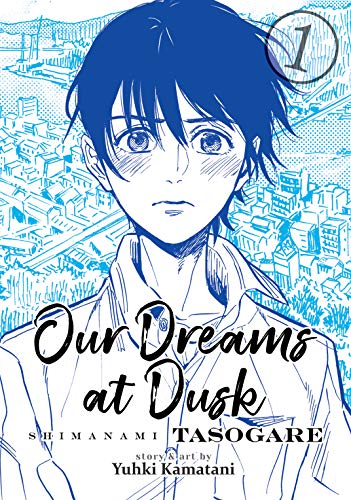By Yuhki Kamatani. Released in Japan by Shogakukan, serialization ongoing in the magazine Hibana. Released in North America by Seven Seas. Translated by Jocelyne Allen. Adapted by Ysabet MacFarlane.
I had heard a great deal of buzz about this title when it was licensed and before, but hadn’t really experienced it beyond people on Tumblr posting pictures of some of the stunning artistic concepts that form part of its story. Having now read the first volume, I remain deeply impressed with the art, but also drawn in by the story and characters. Our Dreams at Dusk gives us a look at LGBT people in Japan and their attempts to deal with these feelings that society – and their own family and peers – tell them is shameful. At its heard is a community founded by the very mysterious “Someone-san”, whose name we don’t know but who has brought together people who need to be able to confess their feelings to, well, someone. It can’t keep being bottled up and repressed. As we see in this first volume, some are more successful than others. And just because you “come out” doesn’t mean your problems are over.
Tasuku is our protagonist, who is high school kid who we fist meet when he’s debating whether he should leap to his death from a high wall. Flashbacks show that someone at high school grabbed his phone and found his browser history, and now are asking if he’s into “gay porn”. He denies it, using a slur he detests, but the truth is that he is gay, though he hasn’t – and feels he cannot – tell anyone or his life will be over. Just the thought of having to return to school the next day drives him to the brink. Before he can do anything, though, he sees a person leap out of a window much higher than where he is. Rushing to the building they were in, he doesn’t find the jumper, but his blurting out that “someone fell” leads him to Someone-san and the group there. Over the course of the book, he opens up to some of them, clashes with others, and continues to go to school, where his crush is on the volleyball team.
Of course, the ensemble cast is important as well. We meet an older man who seems to love Tchaikovsky, a tween-ish child who seems to dislike Tasuku on sight, the friendly and hard-working Utsumi, and Haruko and Saki, a lesbian couple who are still having some issues – Haruko has come out to her family and friends, and dealt with the fallout, while Saki still hasn’t said anything to her family. We also see that the group is not a perfect, all-loving conclave – Saki trying to drag Tasuku into her argument with Haruko shatters the mood a bit. And there is, as I noted, the art, which for the most part is elegant and expressive, but every once in a while shows us a two-page spread of artistic abandon trying to show the torment and desires in the main characters’ hearts. It’d be worth reading the series just for that – but we’re fortunate yo have much more to it.
There’s certainly more to this story, which recently ended in Japan at its fourth volume. I suspect the second one will deal with the kid who clearly does not like Tasuku at all. In the meantime, believe the hype – this is definitely worth your time and money.

